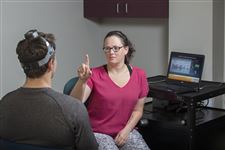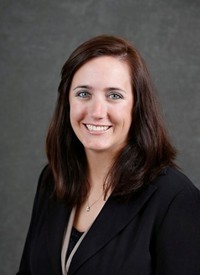
Article reposted from The Blade
Author: ANDREA CRIPPS
When a student-athlete suffers a hit to the head on the playing field, a protocol is observed to determine if a concussion has been sustained.
How long does it take for that athlete to recover from a concussion? What happens in the classroom and who does he or she turn to for help?
That’s where my research at Bowling Green State University’s School of Human Movement, Sport, and Leisure Studies, comes into play. My main research concentration is sensory impairment after concussions: how vision, hearing, and the somatosensory systems are compromised. In addition, she looks at academic decline after a concussion to investigate whether a student’s GPA regresses.
What we’re seeing is that a lot of college students don’t know how to talk to their professors about the challenges they face in the classroom. Even just going to class under the fluorescent lights can be a huge detriment to learning for a student who has sustained a concussion.
College kids don’t understand how much concussions affect them. They might not be able to study, concentrate, or even read a book. Sometimes they can’t even hold a conversation without the symptoms being provoked again.
My aim is to determine if visuo-motor processing deficits, which can occur after concussions, can improve through therapy, which may also reduce recovery time.
So far, one concussion doesn’t seem to be a problem academically, but subsequent concussions can have a much higher impact on students’ “return to learn,” as the NCAA and the Centers for Disease Control have called it.
Symptoms of a concussion include headaches, difficulty remembering, difficulty sleeping, sensitivity to noise, nausea, and sometimes vomiting.
Obviously, headaches are probably one of the biggest symptoms. Students often feel like they are in a fog.
Once an athlete has had a concussion, research suggests he or she is four times as likely to sustain a second concussion. From there, an athlete is 10 times as likely to sustain a third concussion, and the susceptibility continues to grow.
My main goal is to have a better understanding of how to help students in the classroom and what we need to do to get information out to teachers and professors so we can assist them in the classroom.
Even though football concussions get a lot of attention in the media, women’s ice hockey actually has higher incidence rates. Athletes in all sports can get a concussion, not just contact sports. Football numbers are the highest, but the percentage rates of players that sustain concussions are actually highest in hockey.
You hear about football because schools have the greatest number of athletes playing and participating in football. You’re actually more likely to sustain a concussion playing women’s soccer, rugby, lacrosse, or ice hockey.
My research is focused on college athletes, but I plan to study high school-aged student-athletes in the near future.
My plan is to set up preseason testing for the surrounding Wood County schools so athletes can set a baseline standard before they begin participation. Then if they ever get a concussion, I’ll be able to retest them so I can provide the student-athletes and their physicians with a better assessment than they would typically get in an office.
The evaluations before and after would offer a basis for comparison.
I would do some balance testing with them, as well as cognitive testing and some visual testing just to get a baseline measure. And then if they do get a concussion, I would repeat the measures to see how they are changing.
Ultimately, I want to make student-athletes more aware of concussions and what they can do to aid their recovery so they don’t get lost in the classroom.
The media is doing a great job of bringing concussions to the forefront, but at the same time it is a scary situation if you’re not well-informed. Getting the truth out about concussions is important. If I could change the world, I’d like to make sports safer. That is a big goal.
Andrea Cripps, PhD, is a certified athletic trainer who joined Bowling Green State University as an assistant professor in 2015. Ms. Cripps’ research interests include how the sensory systems — visual, vestibular, and somatosensory — are affected following a concussion and how these impairments affect upright balance. For more information, visit bgsu.edu. Bowling Green State University will have a science column featured in The Blade on the last Monday of every month.
